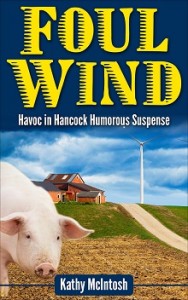
Before my post, let me remind you that my campaign on KindleScout for a contract with Amazon is coming to an end. I need all the nominations I can garner in these last few days. It ends on September 19th. It’s easy to nominate books and if they’re chosen, you get a free pre-release copy. Just go to KindleScout and read more about my book and others.
Let me know you nominated Foul Wind, and I’ll be sure you get a free ebook whether or not I get the contract.
Okay, that’s my point of view. Now on to some thoughts on point of view. From, of course, my viewpoint.
Stories are told from some point of view. Somewhat like the different lenses of a camera, the viewpoint can be distant or very close. Omniscient point of view sees and reports on the characters and the action from some point where “all” is known and can be seen. Stories told in this point of view can share descriptions of setting and characters and the thoughts and opinions of all characters, because the narrator/writer knows all and sees all. This point of view can get up close and personal with a character’s emotions or remain distant.
Second person is written using you. “You go to the dermatologist and she tells you those ugly age spots are ‘wisdom spots,’ and you want to throttle the thoughtless tadpole. Or tell her to wait until she turns into a frog.”
Third person point of view, and I am simplifying a lot here, tells a story as if one person is reporting on the action, in “he ate three potato chips,” style.
First person point of view tells the story from one person’s viewpoint. “I felt like a French fry among scalloped potatoes in my elegant family.”
The protagonist of a first person novel knows only what she sees or hears or is reported to her by others. The reader’s knowledge is also restricted to that which the POV character knows.
A strong, close point of view helps tell a stronger story. When you reveal a scene through the eyes of the character who cares most about its outcome, the scene takes on power and emotion.
A story can talk about a hanging, let’s say. In omniscient point of view (POV), the narrator would describe a crowd of onlookers, and![noose[1]](http://kathymcintosh.com/wp-content/uploads/2015/09/noose1-104x300.gif) tell us they are watching because they’re pleased that a notorious killer is meeting justice. Tell us about this hanging from the eyes of the daughter of the killer’s third victim, and we care more. Tell us from the eyes of a woman who escaped his knife and helped in his capture and we perhaps care even more. We’ll see different details and feel deeper, stronger emotions. If we’ve had the chance to meet the daughter or the would-be victim before, seen her do something that endears her to us, we’re likely hooked. She need not save a kitten. She could simply exhibit a few natural emotions and frailties that we can identify with. We’ll want to know what happens next.
tell us they are watching because they’re pleased that a notorious killer is meeting justice. Tell us about this hanging from the eyes of the daughter of the killer’s third victim, and we care more. Tell us from the eyes of a woman who escaped his knife and helped in his capture and we perhaps care even more. We’ll see different details and feel deeper, stronger emotions. If we’ve had the chance to meet the daughter or the would-be victim before, seen her do something that endears her to us, we’re likely hooked. She need not save a kitten. She could simply exhibit a few natural emotions and frailties that we can identify with. We’ll want to know what happens next.
Writing point of view can be tricky. You need to restrict what the point of view character observes only to what is outside that character, and through the eyes of that character. For example, if you’re in the point of view of a self-conscious teen, you might not want to write, “Cara shook her long, lush curls free from the restraining scarf.” More likely it would be something like, “Cara dragged the stupid scarf from her head, snagging her hair and leading no doubt to yet another mare’s nest of split ends in her mouse brown mess of curls.” And you’d have to consider whether a teenager would use the term mare’s nest.
To better understand point of view (and if you enjoy historical romance), you might want to read a few of Lauren Willig’s fun “flower” novels, beginning with THE SECRET HISTORY OF THE PINK CARNATION. Romance, espionage, history, and humor abound in the series.
What I found fascinating is how the shifting point of view of a character portrays an almost totally different person. I’ve always known that the villain is a hero in his/her eyes. In this series, one character is “foiled” in achieving her goal in one novel, and appears rather frivolous and ill-intentioned from the point of view of the protagonist of that novel. In the next novel, the “bad sister” becomes the heroine and the writing is from her point of view and she no longer seems villainous. Behavior that seems tacky from one point of view becomes justified, thoughtful, normal from within that character.
Novelists these days take liberties with the old rule of choosing a point of view and sticking with it. They may include one section that’s in first person and add others that are in third person, or mix it up even more.
The objective is to tell a good story and not confuse the reader.
I’ll save my rant against head-hopping for another post.
I’d love to know the POV you choose and why.
I’d also love your nomination on KindleScout!